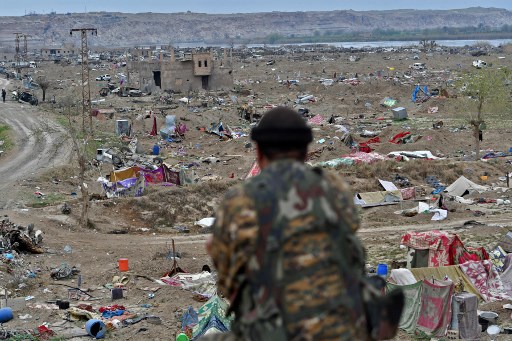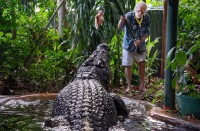
by Tony Gamal-Gabriel
Agence France Presse
BAGHOUZ, Syria (AFP) — Suicide bombers, snipers, rockets — Islamic State group fighters did everything they could to defend their last scrap of territory in eastern Syria, but their diminished resources were not enough.
The US-backed Syrian Democratic Forces on Saturday declared victory over the jihadists in the remote village of Baghouz, after reducing their once terrifying proto-state to a ghostly riverside camp.
From the top of an abandoned building overlooking the devastated encampment, SDF fighter Hamid Abdel Aal points to an earth berm half way to the Euphrates River.
“We arrived at night. We were there at that barricade,” says the man in his thirties, a checkered green scarf wrapped around his jet black hair.
“In the morning, they attacked. They had snipers shooting at us,” he says, a large yellow flag of the Kurdish-led SDF billowing behind him after their victory.
For four hours, the jihadists fought back, he said. But in the end, they retreated to the reedy river edges.
“Eight of them blew themselves up. Others handed themselves over,” says Abdel Aal, who has been fighting with the Kurdish-led SDF since 2016.
Abdel Aal, who hails from the northeastern Kurdish province of Hassakeh, shows off war scars acquired in years of battle.
On his right side is a gunshot wound sustained during the battle for the jihadists’ former de-facto Syrian capital of Raqa, on his neck a scar from a mine explosion.
– ‘Hiding in tunnels’ –
Another fighter named Omar, a slim 31-year-old wearing a mismatching uniform, also recalls the past days of battle.
Even as SDF forces advanced backed by the air strikes of a US-led coalition, the jihadists “would attack sporadically”, he says.
“Suicide bombers would leap out of tunnels. Most were foreigners — from Kazakhstan, France, Saudi Arabia and Iraq.”
There was a time when the jihadists injected fear and claimed deadly attacks across the Middle East and beyond.
After declaring a “caliphate” in Syria and Iraq in 2014, they ruled over millions in territory the size of the United Kingdom.
But in the previously unheard of village of Baghouz, the group’s fighters have emerged from tunnels and caves in the rocky hillside to surrender.
On Sunday, AFP reporters saw dozens of people — mostly bearded men in heavy woollen tunics, some with their faces concealed in a scarf — trudge out of the battered camp.
“They were hiding under the hill or in tunnels,” Omar says.
“It’s normal. At any time, you can see them emerge from a trench,” says the father of three girls and a boy, who has also fought the jihadists on other fronts.
– ‘Tom and Jerry’ –
“The battles used to be more ferocious,” Omar says.
“They used to be at the peak of their force. They used car bombs, heavy artillery, drones, and planted explosive devices in homes,” he says.
At the height of their rule, IS collected taxes and stamped their own coins.
Now all that remains of their “caliphate” are charred vehicles, plastic basins, the odd gas stove, and blankets or sheets thrown over hastily dug-out trenches.
Two dead bodies, a blue plastic water can stuffed with explosives, and a book in the Cyrillic alphabet lie in the ruins.
“Until the end, they had rocket-launchers. They would shoot at our cars from afar,” says SDF fighter Hisham Haroun, a gun in its holster slung over his shoulder.
“They were strong, but it wasn’t the IS strength of yonder years,” says the stocky combattant with grey eyes, a military cap on his head.
“When we started fighting IS, they had combat expertise, military strategies,” he says, a walkie-talkie clipped into his pocket.
“But towards the end, it was like Tom and Jerry — like a mouse in a corner,” he adds.
“It no longer has a way out from the cat.”
© Agence France-Presse







